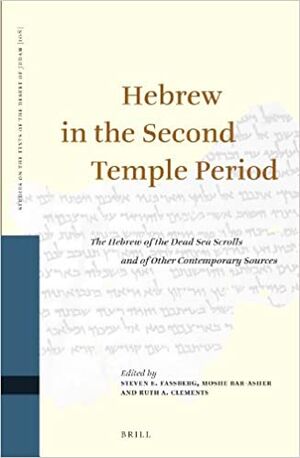Hebrew in the Second Temple Period (2013 Fassberg, Bar-Asher, Clements), edited volume
Hebrew in the Second Temple Period (2013) is a volume edited by Steven E. Fassberg, Moshe Bar-Asher and Ruth A. Clements.
Abstract
This volume offers a multi-disciplinary examination into the Hebrew of the Second Temple period as reflected in the Dead Sea Scrolls, Ben Sira, inscriptions, Greek and Latin transcriptions, the Samaritan oral and reading traditions of the Pentateuch, and Mishnaic Hebrew.
"The Hebrew of the Dead Sea Scrolls and the book of Ben Sira can be properly understood only in the light of all contemporary Second Temple period sources. With this in mind, 20 experts from Israel, Europe, and the United States convened in Jerusalem in December 2008. These proceedings of the Twelfth Orion Symposium and Fifth International Symposium on the Hebrew of the Dead Sea Scrolls and Ben Sira examine the Hebrew of the Second Temple period as reflected primarily in the Dead Sea Scrolls, the book of Ben Sira, Late Biblical Hebrew, and Mishnaic Hebrew. Additional contemporaneous sources—inscriptions, Greek and Latin transcriptions, and the Samaritan oral and reading traditions of the Pentateuch—are also noted."--Publisher description.
Editions
Published in Leiden, Netherlands: Brill, 2013 (Studies on the Texts of the Desert of Judah, 108).
Contents
- Gary A. Anderson, How Does Almsgiving Purge Sins?
- Moshe Bar-Asher, Mistaken Repetitions or Double Readings?
- Haim Dihi, Linguistic Innovations in Ben Sira Manuscript F
- Mats Eskhult, Relative ha-: A Late Biblical Hebrew Phenomenon?
- Steven Fassberg, Shifts in Word Order in the Hebrew of the Second Temple Period
- Gregor Geiger, Plene Writing of the Qōṭēl Pattern in the Dead Sea Scrolls
- Pierre Van Hecke, Constituent Order in היה Clauses in the Hebrew of the Dead Sea Scrolls
- Avi Hurvitz, Terminological Modifications in Biblical Genealogical Records and Their Potential Chronological Implications
- Jan Joosten, Imperative Clauses Containing a Temporal Phrase, and the Study of Diachronic Syntax in Ancient Hebrew
- Reinhard Kratz, Laws of Wisdom: Sapiential Traits in the Rule of the Community (1QS 5–7)
- Noam Mizrahi, Aspects of Poetic Stylization in Second Temple Hebrew: A Linguistic Comparison of the Songs of the Sabbath Sacrifice with Ancient Piyyuṭ
- Matthew Morgenstern, The Literary Use of Biblical Language in the Works of the Tannaim
- Elisha Qimron, The Third Personal Masculine Plural Pronoun and Pronominal Suffix in Early Hebrew
- Jean- Sébastien Rey, On the Prepositional Object with bet in Qumran Hebrew
- Ursula Schattner-Rieser, From the “Foundation” of the Temple to the “Foundation” of a Community: On the Semantic Evolution of *ʾUŠ (אוש) in the Dead Sea Scrolls
- David Talshir, Syndetic Binomials in Second Temple Period Hebrew
- Emanuel Tov, Scribal Features of Two Qumran Scrolls
- Alexey (Eliyahu) Yuditsky, The Non-Construct כל/הכל in the Dead Sea Scrolls
- Francesco Zanella, Between “Righteousness” and “Alms”: A Semantic Study of the Lexeme צדקה in the Dead Sea Scrolls
- Tamar Zewi, Content Clauses in the Dead Sea Scrolls
